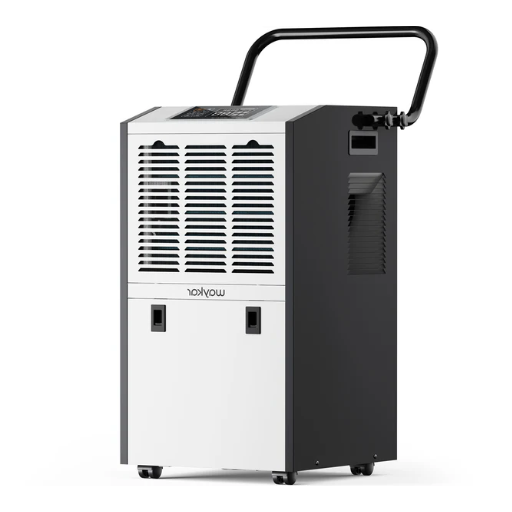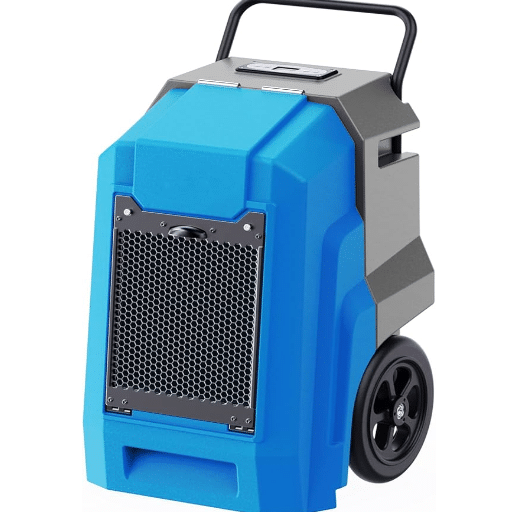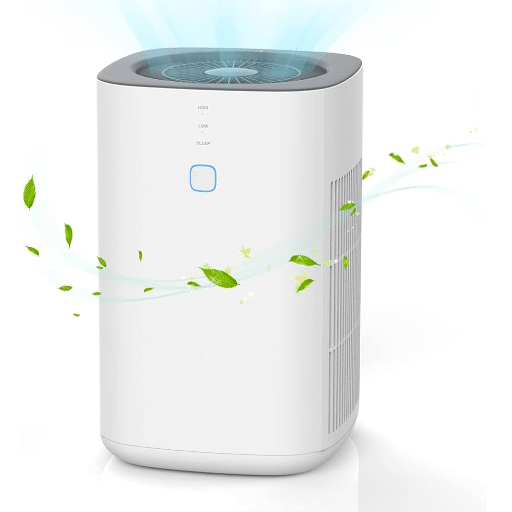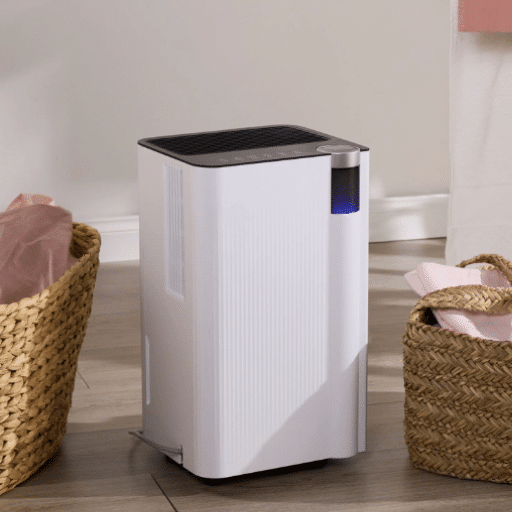Maintaining optimal humidity levels is critical in industrial environments where air quality and equipment performance directly impact operations. Choosing the right industrial dehumidifier is not just about managing moisture; it’s about protecting your assets, preventing costly damage, and ensuring the health and safety of your workspace. With a wide variety of options on the market, finding the perfect dehumidifier for your specific needs can feel overwhelming. This guide will walk you through the key considerations and technical factors to help you make an informed choice, ensuring your space remains efficient, safe, and moisture-free. Whether you’re dealing with excess humidity in a warehouse, factory floor, or storage facility, this article will equip you with the knowledge to select the ideal solution.
What is a commercial dehumidifier, and how does it work?
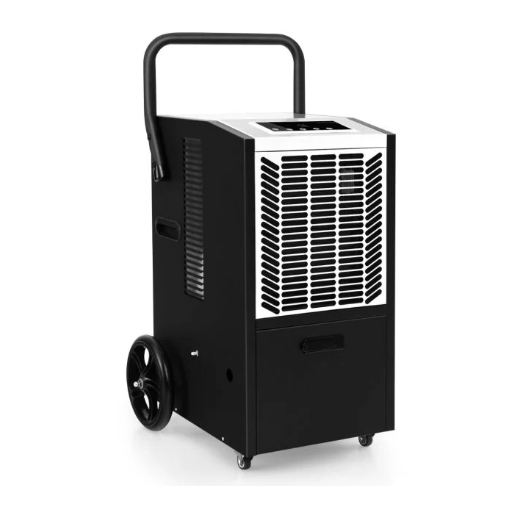
Understanding commercial dehumidifier systems
A commercial dehumidifier is, in essence, a giant moisture-removal apparatus that can dehumidify the air in large spaces like an industrial shed, warehouse, or commercial building. It measures the water vapor content in the air to correct the moisture in the atmosphere. Most systems take the humid air inside, chill it to condense moisture, warm it again, and then let the dry air out. This process is best suited to maintaining a dry space, which, in turn, keeps away damage to equipment, billed, or the floor.
The key components of a commercial dehumidifier are generally some type of compressor, refrigerant coil, fan, and water collection or sanitation system. The compressor forces the refrigerant through the coils, whereas the humid air comes into contact with these cool coils and gets moisture from the air in condensation form. The water formed may be collected in a tank or disposed of straight away, while the dry air is reheated and then exhausted into the environment. More advanced versions may have sensors to monitor the humidity level and automatically adjust the operation to maintain the desired state.
Commercial dehumidifiers can vary their capacities in terms of pints or liters of moisture removed within any given time. Factors such as the size of the environment and its present humidity level, and control requirements on the site should be given due importance when selecting a dehumidifier. For instance, food storage or pharmaceutical establishments may need stringent humidity control for the sake of product quality and safety. Understanding this can be a viable option as to how these systems work and where they are useful to provide your business an efficient and reliable solution for moisture control in commercial settings.
How industrial dehumidifiers remove moisture
Industrial dehumidifiers reduce moisture from the atmospheric air by performing the cycles of air intake, moisture extraction, and air redistribution. These dehumidifiers draw in humid air through an intake port where the air depends on its category and, accordingly, may be passed over cooling coils or into desiccant materials: The cooling coils cause water vapor to condense into a liquid form that can be collected and drained away, while desiccant-based systems absorb moisture directly from a hygroscopic material. Thus, they can both lower the ambient humidity level.
Condensation forms the basis of water removal in the refrigerant dehumidifiers. Compressors and coils cool the air below its dew point. While the water vapor condenses into droplets, either the droplets are collected in a reservoir, or they may be lodged in building drainage. This works well in higher humidity and temperature conditions, aka, above 40°F (4°C). Although when the temperature lowers, it begins to lose efficiency because of icing on the coils.
Desiccant dehumidifiers use materials such as silica gel that are filled with spirits. Pure humid air is passed through the system, where it is bad for water vapor. This method is highly effective in keeping low humidity at low temperatures or wherever special humidity standards are needed. The desiccant, upon saturation, is regenerated using controlled heating so that the dehumidifier can perform continuously all the while. These are of special interest where low humidity to precise levels is critical for the smooth functioning of the process-whether it be pharmaceutical, cleanroom, or industrial.
Key components of a commercial dehumidifier
A commercial dehumidifier is engineered for high-capacity moisture removal swiftly, in an exact manner. Robust and, accordingly, designed to withstand pounding conditions in actual working environments, the primary components allow for continuous performance and can be adapted for various industrial uses. The following are the essential components that form the backbone of these systems:
- Compressor: The compressor is the heart of a refrigeration dehumidifier. It compresses the refrigerant to undertake the heat exchange activities that remove moisture from the air. The compressors in commercial dehumidifiers are built to operate under very heavy-duty conditions; they support continuous operation for long periods.
- Evaporator and Condenser Coils: The evaporator coil cools down the incoming air by condensing moisture that comes in the form of water droplets. These water droplets get collected and drained. The condenser coil reheats the air after being discharged into the environment to ensure comfort within the area and to keep it from getting too cold.
- Desiccant Rotor (for Desiccant-Based Systems): Desiccant dehumidifiers employ a rotor of silica gel or similar substances to adsorb moisture from the air. This component is indispensable to attaining ultra-low humidity in strict moisture control environments such as laboratories or electronics manufacturing facilities. The rotor is highly efficient and is regenerated thermally to produce uninterrupted performance.
- Air Filter: The air filters protect the internal components from dust and debris, thereby offering better air quality and longer operational life. Filters for commercial setups are often designed to be either replaceable or washable to deal with the volume of pollutants commonly encountered at engineering sites.
- Drainage System: The next line of defense is an active drainage system, working often in tandem with a condensate pump to force out water. This element is crucial for preventing downtime or water from overflowing, particularly in areas where manual drainage is not possible.
- Control Panel and Sensors: Large commercial dehumidifiers are fitted with highly sophisticated control units with integrated hygrometers, temperature sensors, and digital interfaces. They provide an automatic guarantee of precision in humidity measurement and program-user-defined optimum conditions.
The synergy of the above components has allowed commercial dehumidifiers to develop a domain covering the entire gamut of industrial and commercial applications, where a consistent, reliable, and entirely efficient moisture control is required. Maintenance of each component is foundational to its long-term operation in compliance with the set environmental requirements for these application settings.
How to choose the right industrial dehumidifier for your needs?
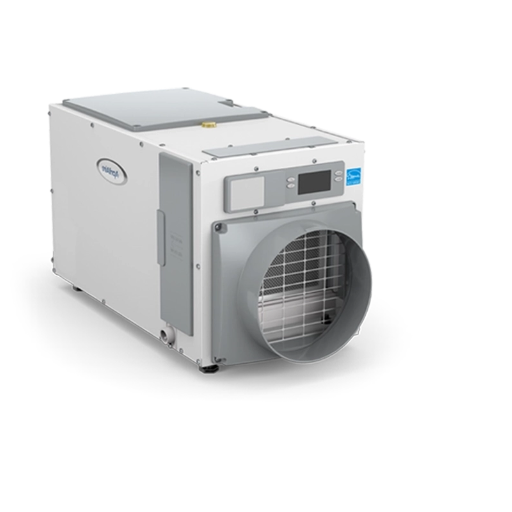
Factors to consider when you choose
- Required Capacity and Load: Industrial dehumidifiers come in various capacities and are usually rated for pints or liters of moisture extracted from the air in a day. The capacity theoretically depends on the volume of the space, the average humidity level in the atmosphere, and the moisture load created by particular environmental conditions or processes. An accurate load assessment will go far in assuring that the dehumidifier will be able to keep the humidity level within the optimum range without having to function more than necessary.
- Environmental Conditions: Environmental conditions are crucial in ensuring the right choice of a dehumidifier, wherein the ambient temperature, relative humidity, and exposure to contaminants such as dust or corrosion-related elements ought to be considered. Desiccant dehumidifiers, for instance, are good for lower temperature applications, while refrigerant types work well to treat air at higher temperatures.
- Energy Efficiency: Consider energy consumption because industrial dehumidifiers tend to run for longer hours. Review the energy efficiency of the system, which can be measured based on the energy efficiency rate (EER) or the coefficient of performance (COP), to understand how efficiently it uses power. The selection of an energy-efficient dehumidifier can also translate into decreased operating costs and which align with sustainability objectives.
- Maintenance Requirements: Frequent maintenance interrupts production and causes costs to inflate; thus, choosing a unit with easy-to-reach components and with less need for servicing is the way to go. Filters that can be washed are just what you want to keep downtime at a minimum, along with self-diagnostics and an auto-defrost function.
- Compliance and Certifications: Dehumidifiers should comply with specific standards and certifications of safety for the industry, such as the UL or CE marks. This becomes an absolute priority when it comes to industries that must profit from stringent environmental or quality control regulations, such as pharmaceutical, food processing, or electronic manufacturing industries.
- Scalability and Integration: In cases where the operations will still be growing or undergoing change, choose a product that supports scalability and integration with existing systems. Most of today’s dehumidifier brands will support integration with the building management system (BMS) for real-time monitoring and seamless integration into the facility’s overall environmental control.
With rigorous consideration given to each attribute, you will be confident that the chosen dehumidifier will perform consistently and be customized to suit your particular industrial or commercial application.
Determining the capacity required for your space
Defining the necessary dehumidifier capacity for a particular space requires an analysis of the environmental parameters, humidity load, and operational modality. Capacity, in general, states the number of pints or liters of moisture extracted in a day. Bigger units are intended for higher moisture loads or larger spaces. The capacity calculations need to take into consideration several factors such as the total area of the space concerned (measured in square feet or square meters), average or peak relative humidity load, and the type of materials present there. Also, they would need to consider how often the water vapor is created through various processes and activities within space.
Since the industrial processes can create a huge amount of steam or moisture (such as food processing or warehouses for materials sensitive to water), requiring efficient handling of heavy loads, a high-capacity system is warranted. In contrast, medium capacity loads for intermediately humid spaces, such as commercial office buildings, are best positioned to keep environmental equilibrium without operational strain.
The use of psychrometric calculations can further help improve the accuracy. On analyzing factors such as air temperature, dew point, and air changes per hour (ACH), one can pinpoint moisture removal requirements more precisely. Tools and software are available today that assist with these calculations to ensure accuracy with optimized system performance. Following industry standard guidelines also adds another level of verification to the selection activities.
Why the right commercial dehumidifier is crucial for your facility
The types of commercial dehumidifiers for proper situation selection are crucial in safeguarding indoor air quality, structure integrity, and functional efficiency. Excess moisture in the environment supports the growth of mold, mildew, and bacteria, thereby contributing to health hazards and the potential damage of sensitive equipment, inventory, or building materials. For example, warehouse, manufacturing plant, or archival storage spaces require stringent humidity control to keep corrosion and warping from tarnishing particular goods and infrastructure.
Modern commercial dehumidifiers perform under varied humidity loads with utmost efficiency while enjoying features such as energy-saving modes, variable-speed controls, and real-time performance monitoring. Purchasing a dehumidifier that fits aptly with your facility’s size, industrial needs, and climatic conditions down the line would reasonably have an impact on maintenance costs and energy utilization. Data from contemporary industrial sources suggests that optimal humidity levels (usually 30% to 50% relative humidity) would increase equipment life by as much as 25% and reduce electricity bills by finely tuning operational conditions of the HVAC systems.
By employing data-driven decisions and tools, combined with compliance to standards like ASHRAE 62.1-2019, facilities can customize their dehumidification strategies to achieve precise control. This ensures long-term reliability and performance, protecting both the environment and your critical assets.
What are the benefits of using industrial dehumidifiers?
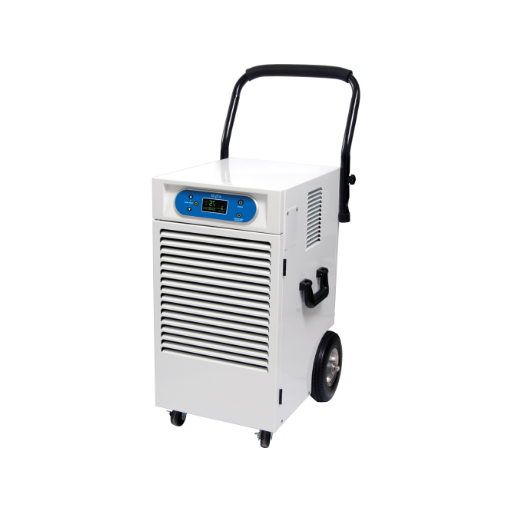
Preventing mold growth and damage in large spaces
From my perspective, the assay proves that industrial dehumidifiers are of paramount importance for controlling mold growth and preventing damage in huge spaces. Mold is favored by environments with a high relative humidity, usually greater than 60%. Maintaining optimum humidity with industrial dehumidifiers gives levels of 40% to 50% where mold would hardly ever grow; hence, such precise humidity control becomes vital, which is tough to execute in huge areas because of environmental fluctuations.
I have also witnessed how much one must be earnest in protecting structural integrity and vulnerable equipment in such an environment. Excessive moisture causes corrosion of materials, affects the wooden parts, and mars finishes. Industrial dehumidifiers serve to prevent expensive damage by constantly and effectively removing excessive water vapor from the air. These machines find their use in warehouses, manufacturing shops, empty warehouses, storage departments, and the like, where the protection of valuable goods from moisture-related damages is of utmost importance.
Last but not least, industrial dehumidifiers provide an enhanced indoor air quality while their significance is often neglected. Health concerns can be exacerbated by poor air conditions brought about by moisture, including respiratory disorders caused by mold spores. My control of the moisture levels ensures that the stitching of the structure goes well, and even better does the health and safety of the occupants. Such multifaceted benefits only reinforce the industrial dehumidifier as a worthy investment toward long-term viability and operational efficiency.
Improving air quality and maintaining a healthy environment
Air quality in any environment plays a fundamental role in ensuring human well-being, especially when the environment is exposed to excessive moisture or contaminants. Poor indoor air quality, therefore, may increase allergens, dust, and VOCs in the air, having detrimental effects on respiratory health, productivity, and general comfort. Advanced ventilation systems with HEPA filtration filter airborne contaminants effectively, reducing exposure to germs or pollutants. These individuals can also disperse odors and VOCs using contemporary air purifiers based on activated carbon technology, thus enhancing air quality.
Maintaining an acceptable humidity level is another important element toward the environmental conditions required to discourage mold growth and bacterial proliferation. Studies have linked mold growth with humidity exceeding 50%; hence, controlling indoor humidity between 30-50% will minimize mold growth while preserving structural strength and improving occupant health. Industrial dehumidifiers, aided by intelligent control systems, continuously monitor and automatically adjust moisture levels are good examples since they produce a healthier indoor climate free of warping and decay to building materials caused by excess moisture.
Data-based solutions are therefore critical to enhancing air quality and environmental health programs. Sensor monitoring systems continuously monitor and record data concerning particulate concentrations, carbon dioxide, humidity, etc., giving actual insights for system optimization. Partnering with these IoT-enabled devices can help a facility change airflow, temperature, and humidity depending on occupancy and environmental factors. Institutionalizing these technologies within a broad air management framework ensures sustainability, energy efficiency, and above all, the promotion of a much healthier environment for living and working.
Energy-efficient solutions for high humidity levels
In practical terms, managing high humidity levels in a sustainable and energy-efficient manner comprises a blend of advanced technologies and a strategically integrated system. One of the best approaches involves employing energy recovery ventilators (ERVs) with either desiccant wheels or membranes. These machines exchange moisture and heat between the incoming and outgoing air streams excellently, thereby maintaining the indoor air quality while reducing energy requirements for typical dehumidification processes. Hence, using an ERV lets facilities maintain a comfortable environment within a price range that offers some savings.
Additionally, variable-speed HVAC systems with humidity control capabilities serve as another proven alternative. Nowadays, variable-speed HVAC advantages include: compressor and fan speeds operate at lower values for longer durations of moisture removal, and also perform the same task with less energy consumption. With demand-controlled ventilation (DCV) added into the system, airflow is regulated on the basis of real occupancy data, thus furthering the dehumidification lifecycle and avoiding wasting energy as unneeded in unoccupied areas. This ensures top-performing operational efficiency, especially in commercial and industrial settings, cluttered with hectic humidity demands.
Lastly, incorporating state-of-the-art building management systems (BMS) to monitor environmental data and automate dehumidification processes from time to time tends to make the system more efficient. For example, BMS can introduce humidity sensors along with IoT-enabled controls and predictive analytics for the dynamic optimization of energy consumption. On the other hand, using the system to pre-chill outdoor air during off-peak hours or when renewable resources are abundant will allow an organization to bring costs down, along with a lesser dependency on standard energy-intensive dehumidification techniques. This form of custom-made smart solution shall be helpful not only for managing humidity well but also for any form of sustainable and energy-efficient building projects.
How do you maintain and care for industrial dehumidifiers?
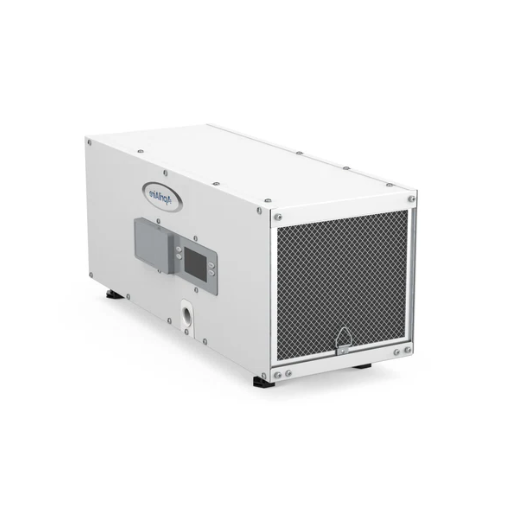
Regular maintenance tips for optimal performance
- Inspect Air Filters Frequently: The Air filters of the dehumidifier for commercial use are essential for dust and airborne particle trapping. These filters must be inspected regularly and cleaned or changed as per the manufacturer’s instructions, usually every 30 to 60 days, depending on how hard the dehumidifier is working and on air quality conditions. This will allow for good airflow while preventing inefficient operating conditions caused by clogged systems.
- Monitor and Clean Condenser Coils: Condenser coils are the most significant element for removing moisture from the air. Over time, these coils tend to gather dust and waste, so the efficiency of heat exchange drops. Cleaning of the coils with a soft brush or the coil cleaner should be considered at least once per three months or whenever required, depending on operating environment conditions.
- Check and Empty Condensate Tanks or Drain Systems: Industrial dehumidifiers require frequent emptying of condensate tanks or maintenance of drainage systems. Inspect the tanks or drains daily for clogs or leaks, ensuring that water is going out, preventing it from overflowing and damaging the unit. This will prevent any damage to the unit due to overflowing. Consider also installing an auto pump for continuous drainage if it is in a very humid environment.
- Inspect Electrical Connections and Controls: Such electrical parts as wiring, panels, and circuit breakers should regularly be inspected for wear, corrosion, or looseness. When these systems begin to fail electrically, it may cause a failure mode or endanger the user. Prompt corrective action is therefore necessary.
- Calibrate Humidity Sensors and Controls: Humidity sensors are to be calibrated at regular intervals to obtain correct readings and give accurate control of environmental conditions. Refer to the manufacturer’s recommendations as to the frequency of the checks, usually every six months to a year, and ensure that the dehumidifier is holding set levels of humidity as would be expected from such calibration.
- Lubricate Moving Parts: Fans or motor-driven moving parts may need lubrication to reduce wear and ensure smooth operation. During scheduled maintenance inspections, lubricate the moving parts using lubricants recommended by the manufacturer so as to avert noise problems or mechanical failure.
- Check for Physical Damage: Every once in a while, inspect for physical damage to the dehumidifier, like dents, rust, or cracks in the housing that would reduce efficiency or safety. Bearing in mind that damaged parts should be neatly repaired or replaced to sustain the structural and performance integrity of the system.
- Annual Inspection and Service by a Professional: Hiring and retaining a certified technician for inspection and service should be done once every year. This was one thing that could be sure of: a deep surgery on the mechanical front and addressing operations that do not meet benchmarks, thereby extending the longevity of the service.
By following these detailed maintenance schedules, a facility would keep industrial dehumidifiers working at maximum efficiency, thereby optimizing downtime and reducing costs over the period.
Ensuring the reliable operation of your dehumidification system
A dehumidification system operates reliably if it is monitored continuously for appropriate performance indices, ensuring the attainment of specified operational requisites. Such critical factors as RH, ambient temperature, flow rates, and power consumption must be logged and evaluated daily. Equipped with sensors and monitoring software, advanced systems enable tracking and diagnostics in real time, giving the operator an early warning for any anomaly, such as random humidity levels or irregularities in energy use. Using predictive maintenance and data analytics, the system in a factory setting could avert failures, optimize efficiency, and contribute to energy conservation.
Industrial-grade dehumidifiers, for example, should maintain specific RH levels between 30% and 50%, depending on their application. Any departure from these prescribed values could suggest pending issues wherein faulty air filters, refrigerant leaks, and damaged ductwork immediately warrant investigation. It is the same with rising energy consumption even under stable environmental conditions; it might signal a deterioration of vital components such as compressors or motors.
By embracing automated reporting systems and evidence-based performance protocols, the facility stands to gain reliability with a longer life expectancy.
Why is a commercial dehumidifier essential in industrial settings?

Addressing excess humidity in factory environments
Some of the negative consequences that industrial humidity presents are deterioration of structures, malfunctioning of equipment, or interference with product quality, among others. High levels of humidity cause corrosion to the metallic parts, enhance mold development, and deteriorate sensitive electronics or machinery. For instance, it is reported that relative humidity beyond 70% largely favors mold generation and rust formation, translating to expensive repair and maintenance.
Meanwhile, excess moisture creates detrimental effects on worker productivity and safety. Hot and humid conditions can cause an uncomfortable working environment and decrease work efficiency; equally concerning are the health hazards that may arise from increased humidity, including respiratory problems and heat stress. This concern is prominent within industries such as pharmaceuticals, food production, and automotive manufacturing, where strict environmental controls are held to meet regulatory standards and guarantee product integrity.
Modern industrial dehumidifiers are built to maintain the ideal humidity conditions while employing energy-saving technologies and sophisticated humidity sensors. In such a way, desiccant wheels or refrigerant-based systems may be used to extract excessive moisture from the air. The integration of intelligent control systems with continuous monitoring ensures that facilities attain dependable humidity control with the lowest possible energy requirements, thereby upholding industry standards and operational efficiency.
The impact of uncontrolled humidity on building infrastructure
Uncontrolled humidity poses a big threat to the building infrastructure, with a risk of structural damage, curtailment of material life, and maintenance cost enhancement. Some of the significant consequences of excess or less humidity include:
- Material Degradation and Decay: High humidity causes materials such as wood, drywall, or insulation to absorb moisture and suffer distortion or swelling and decay. Research has shown that wood tends to deteriorate when relative humidity exceeds 70 percent for long durations, thereby compromising the structural integrity.
- Corrosion of Metals: The effect of humidity on metals is to hasten the slow rust and corrosion. Construction structural steel can suffer a lot of weakening when relative humidity remains above 60% for a long time.
- Mold Growth and Fungal Infestation: Molds and mildew exist in imperfect humidity conditions, generally above 50%. Prolonged mold growth can damage building materials and also present health hazards to the inhabitants. Environmental health studies link poor humidity control to indoor mold infections in more than 30% of buildings surveyed.
- Damage to HVAC Systems: On the contrary, uncontrolled humidity and moisture may affect the HVAC (Heating, Ventilation, and Air Conditioning) system adversely. Too much moisture condensing in the ducts and other components will spawn microbes and eventually cut down on the system’s efficiency. And pockets of low humidity may lead to overheating or cracking in some critical parts of gaskets and seals.
- Compromised Thermal Insulation Performance: Moisture penetration results in the loss of thermal resistance (R-value) of insulation and hence its ability to maintain an indoor environment. Research findings show that wet insulation loses up to 40% of its insulating value, leading to an escalation of energy consumption and operating expenses.
Therefore, the discussed effects highlight the need for strict humidity control measures to be put in place for the longevity and safety of building structures.
Creating a comfortable and productive work environment
A comfortable and fully productive space is highly subject to the optimization of air quality and other environmental factors such as lighting, sound, and temperature. Research affirms that air quality defects caused by inappropriate ventilation or the presence of elevated levels of indoor pollutants can diminish cognitive capacity by 50%. An exchange of clean air in appropriate amounts combined with preparations for purifying the air from fine particulate matter below 2.5 (PM2.5), allergens, and microorganisms is essential for assuring employee well-being and long-lasting productivity.
Furthermore, lighting is another factor. Studies have shown that natural lighting or the option to adjust the intensity of artificial lighting enhances mood, lessens fatigue, and improves sleep quality by being in sync with the circadian rhythm. Noise control is also important because stresses are linked to background noise exceeding 50 dB, and decreased focus may result. Thoughtful application of absorptive surfaces and various noise barriers can nearly resolve such interruptions.
Smart HVAC systems equipped with sensors and control mechanisms would provide for the maintenance of these conditions in an energy-efficient manner. By concentrating on these variables and incorporating state-of-the-art technology for measurement and control, companies will be able to create healthier and highly performing environments in which employee satisfaction lies side by side with operational excellence.
References
-
Characteristics of an adsorption-type dehumidifier – Analysis of silica gel and other desiccants used in dehumidifiers.
-
Model predictive control for energy efficient cooling and dehumidification – Exploration of dehumidification strategies and their performance across different climates.
-
Thermal design of Humidification Dehumidification systems for affordable and small-scale desalination – Insights into the design and efficiency of dehumidification systems.
Frequently Asked Questions (FAQ)
Q: What factors should I consider when choosing an industrial dehumidifier?
A: When selecting the best industrial dehumidifier for your space, consider the size of the area, the humidity levels, and the specific needs of the environment. For example, basement and storage areas might require dehumidifiers that can handle colder temperatures. Look for features like built-in humidity controls and portability for ease of use.
Q: How do I determine the appropriate capacity for a dehumidifier?
A: The capacity of a dehumidifier is usually measured in pints per day. For industrial spaces, a range of commercial dehumidifiers is available, from smaller units around 70 pints to larger, more powerful models. Consider the size of your space and the level of humidity to determine what capacity is suitable.
Q: Are portable dehumidifiers effective for industrial use?
A: Yes, portable dehumidifiers can be effective, especially in smaller or segmented areas where flexibility is needed. However, for larger spaces, you might want to consider stronger, built-in options that can deliver more efficient performance.
Q: What’s the difference between commercial and industrial dehumidifiers?
A: Commercial dehumidifiers are typically used for spaces like offices or retail environments, while industrial dehumidifiers are designed for more demanding environments, such as warehouses or manufacturing facilities. Industrial units are generally stronger and capable of handling higher moisture loads.
Q: How can using a dehumidifier prevent costly repairs?
A: By maintaining optimal humidity levels, dehumidifiers can prevent moisture-related issues such as mold, mildew, and rust. This can help avoid costly repairs to structural components and equipment in industrial settings.
Q: Is a quieter dehumidifier always better for industrial spaces?
A: While quieter operation is desirable in environments where noise is a concern, such as offices or residential areas, in industrial settings, performance often takes precedence. It’s essential to balance noise levels with the unit’s ability to effectively manage humidity.
Q: What is the best commercial dehumidifier for colder environments?
A: For colder environments, look for dehumidifiers specifically designed to operate at lower temperatures. Some models are built with features that prevent freezing and ensure efficient operation in cooler conditions.
Q: How does a built-in dehumidifier differ from a portable one?
A: Built-in dehumidifiers are typically installed into a space’s infrastructure and are meant for permanent use in larger areas. They deliver continuous dehumidification without needing to be moved. Portable dehumidifiers, on the other hand, offer flexibility and ease of use in various locations.
Q: What are some suitable applications for industrial dehumidifiers?
A: Industrial dehumidifiers are suitable for a wide range of applications, including warehouses, manufacturing facilities, and storage areas. They are designed to handle considerable moisture loads and maintain optimal environmental conditions.

